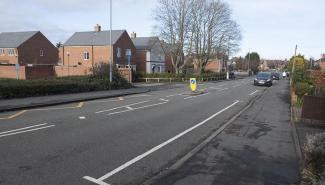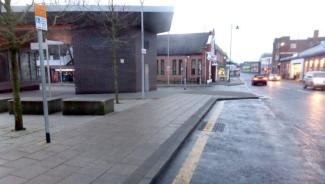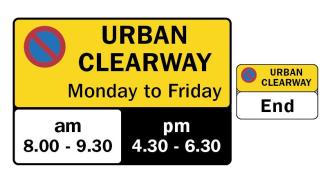Parking prevention measures are used to discourage unauthorised parking and to prevent motorists parking in unsafe environments.
Bollards

To prevent cars parking on pavements and verges, physical measures can be used such as bollards (or planters) which can act as an obstruction to avoid cars parking on footways and verges.
Bollards can also be used at points where pedestrians need to cross the road safely.
Bollards are relatively easy to install and are low maintenance but can add to street clutter and are prone to damage. Parishes/town councils/community groups would be responsible for all installation costs, plus ongoing maintenance and liability costs.
The introduction of bollards can transfer the problem elsewhere and it isn’t possible or practical for the Leicestershire County Council to erect bollards on every footway throughout the county.
H bars

H bar markings are white lines that are marked on the road in front of access areas. The lines are advisory markings highlighting to other road users that they shouldn’t block access to off-road parking areas such as driveways and garages.
Find out how to apply for a H-bar marking in Leicestershire.
Disabled parking bay

A disabled bay may be advisory or mandatory. If someone in your household is disabled and has a blue badge you can apply to have a disabled parking bay marked outside your home. Having a disabled parking bay outside your home doesn’t guarantee a space for you or the disabled person in your household. This is usually an advisory marking.
A mandatory disabled bay is usually provided in town centres reserving a road space for blue badge holders. It is an offence to park in these bays without displaying a blue badge and clock.
Further reading
Sheltered parking

This normally involves the introduction of a footway or verge build-out at the end of existing sections of on-street parking. The parking would be defined by a white line or a change in the carriageway surface. Whilst visually narrowing the appearance of the road, sheltered parking offers a degree of protection to parked vehicles and the build-outs can provide safer points for pedestrians to cross the road near to parked vehicles.
Build-outs can be difficult to achieve where there are many private driveways restricting their position.
Red routes

Red Routes are double red lines and are placed on busy main roads. They are designed to stop drivers from parking dangerously on the road and verges and prohibit any stopping, loading or unloading, and boarding or alighting from a vehicle along that route.
The red route comprises the whole width of public highway, from building line to building line, which in most cases includes footways, verges and crossovers.
Red routes are used strategically, to deal with traffic problems on a whole-route basis for example the roads around East Midlands Airport.
Red Routes aren’t intended to deal with issues on relatively short lengths of road such as areas outside schools.
Red Routes can also be enforced through the use of closed-circuit television (CCTV).
Prohibition of stopping

Areas of the highway can be restricted for certain classes of vehicles such as taxis or buses during periods of the day.
Other vehicles are prohibited from stopping on these markings.
Prohibition of waiting and loading

Double yellow lines prohibit vehicles from waiting at any time of the day. Double yellow lines are only usually introduced for safety reasons or to help the flow of traffic.
Where a grass verge is situated alongside double yellow lines, the prohibition of vehicles waiting at any time of the day applies to the whole of the highway, which includes footpaths and verges.
A single yellow line prohibits waiting at certain times of the day and is indicated by a sign, for example Monday - Saturday 8am - 6pm. Outside of these times parking is allowed.
A prohibition of waiting restriction does allow for certain activities such as loading, boarding and alighting. Blue badge holders can also park for up to 3 hours displaying a blue badge and clock showing the time of arrival.
A prohibition of loading is indicated by double and single kerb tabs. A double kerb tab denotes that loading is prohibited at all times whereas a single kerb tab shows that loading is prohibited at certain times of the day where a sign will show times for example Monday to Saturday 7.30am - 9am and 4.30pm - 6pm.
On street parking places (limited waiting bays)

Limited waiting bays are parking bays that typically include several parking restrictions that apply at particular times. For example, a limited waiting bay could include a restriction which only allows parking for up to 1 hour, with no return within 1 hour, between the hours of 6am and 6pm, Monday to Friday.
Limited waiting bays are usually installed near shops and in town centres to allow short-term parking for visiting shops or businesses. Information about when and or how long you can park in a limited waiting bay is displayed on the signage.
Parking spaces can also be restricted to certain classes of vehicles such as coaches, electric vehicles, blue badge holders and for loading.
Urban clearway

Urban clearways are used to ease traffic flow in towns and cities during busy periods.
The sign for an urban clearway stipulates information on the particular times that the urban clearway rules are in effect. An urban clearway could be enforced for example on weekdays between 8am and 9.30am, then again between 4.30pm and 6.30pm. At the end of the zone, there will be an urban clearway end sign to tell you that the rules are no longer in force.
During the hours of enforcement for an urban clearway, you can’t stop or park your vehicle except briefly to pick-up or drop-off passengers. When the urban clearway is outside its hours of operation you can stop or park where the normal road markings allow.
Resident parking permits

To apply for a residents parking permit a location is required to meet all the following criteria:
- At least 50% of the properties affected have no off-street parking facility.
- Residents are unable to park because at least 40% of available kerb space is occupied by non-residents during the normal working day, usually commuters near a town centre or factory premises, who should be using alternative parking that is provided.
- There is sufficient on road space to allow at least one vehicle per household for those who wish to participate in the scheme.
There is also an on-going cost to residents for a permit scheme, this is currently £50 per year, per permit. This however only increases the chance of parking within the residents parking zone but doesn’t guarantee a space within the parking zone or on a specific street.
Further reading
Dropped kerb (Vehicle access)

If you want to drive a vehicle over the pavement into your driveway off a highway then you’ll need a dropped kerb. If you don’t have a dropped kerb, you mustn’t drive over the pavement. If you do, you’re breaking the law and enforcement action could be taken to prevent this. A dropped kerb is used to give access to vehicles from a road across the pavement and onto a driveway or parking area.
These lower height kerbs can be used to create vehicle access points for private drives or to provide easier movement for pedestrians, wheelchair and buggy users who are crossing the road to and from the footway.
Pedestrian dropped kerbs can be considered on their own, or as part of a scheme with tactile paving.